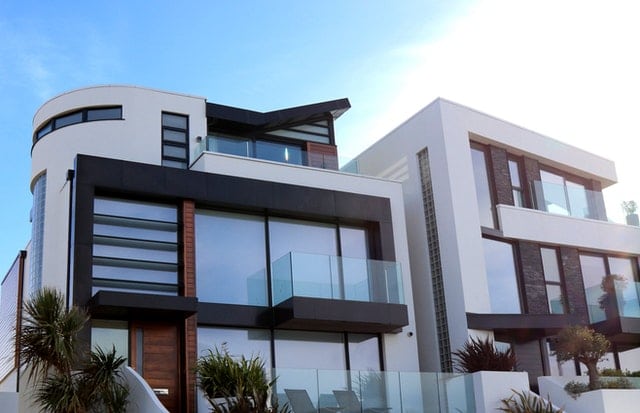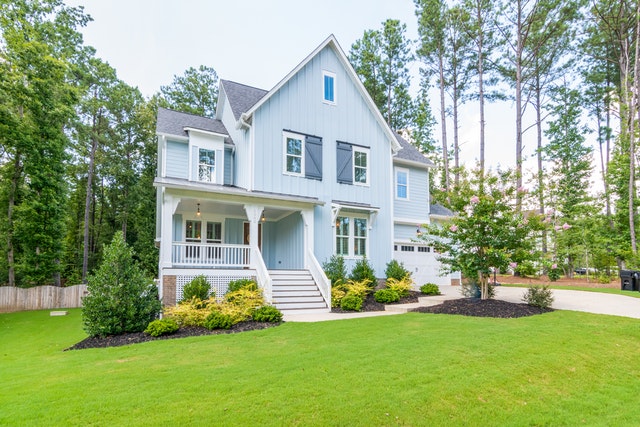If you’re interested in tapping into some of the equity in your real estate portfolio, you might be curious to learn more about getting a HELOC on rental property.
Investors can use HELOCs to fund any number of endeavors, whether it be purchasing a new property, consolidating debt, or rehabbing a property.
However, there are definitely pros and cons to getting a HELOC from an investment property. If you’ve ever been through the process with a primary residence, it’s worth understanding that there are some important differences in terms of the cost and the criteria for qualification.
So, without further ado, let’s take a look at everything you need to know about getting a HELOC on rental property.

A home equity line of credit (HELOC) is a type of lending product that serves as a revolving line of credit. Rather than being a loan you receive in a lump sum, a HELOC allows you to borrow up to a maximum loan amount over time. This can be a great solution for people who don’t know precisely how much money they’ll need to borrow.
When you’re approved for a HELOC, you’ll enter an initial draw period. How long this period lasts depends on your lender, but it’s typically about five to ten years. During this period, you’ll make minimum payments in order to cover the cost of interest and you can withdraw money as you need it.
After the draw period has finished, the repayment period will begin. How much money you borrowed and your lender’s terms will dictate how long the repayment period is. However, it’s common for this period to last up to twenty years.
During the repayment period, you’ll make payments to pay back both the money you owe and the interest.
Are you wondering how to calculate property value based on rental income? Check out this article to learn more.

Getting a HELOC on a rental property is very similar to getting a HELOC on your personal residence. However, there are some important differences that you’ll want to be aware of before you bank on getting a HELOC from your investment property.
If you purchased your investment property with a mortgage, you’re probably already aware of the fact that lenders tend to see rentals as a riskier endeavor than personal homes. The reason for this is because lenders believe that, if a borrower gets in financial trouble, they will likely focus more on repaying loans for their primary residence rather than properties they don’t live in.
Lenders are also all too aware of the fact that you are likely interested in building a rental portfolio that includes multiple properties. They tend to see the fact that your assets are tied up in a number of properties as something that puts you at a higher risk of default.
The same goes for HELOCs on rental properties– lenders see you as higher risk as a real estate investor than they would if you were just a homebuyer. This means that you should expect the fees and interest rate to be higher for an investment property HELOC than for a personal residence HELOC.
The fact that lenders see HELOCs on rental properties as riskier than those on personal residences means that you also might have a harder time finding a lender to extend a line of credit to you. Lenders are motivated to only give out lending products in circumstances where they believe that there is a high probability that the borrower will repay their loan on time.
What this means is that you’re probably going to have to shop around a bit for a lender if you want a HELOC on rental property. As mentioned above, you should also expect that the terms you’ll be offered will be less favorable than for a primary residence, including higher fees and a higher interest rate.
Once you manage to find a lender that is willing to offer HELOCs on rental properties, the next step will be qualifying. There’s a good chance that any lender you do find will have very strict approval requirements.
If you’re facing financial problems in a way that’s motivating you to try and get a HELOC, you might not be able to find a lender that will approve you.
All lenders will have their own requirements when it comes to approving investors for a rental property HELOC. In general, though, you will need to meet the following requirements:
There are other features that can help you qualify for a rental property HELOC, such as proving that your property has long-term tenants.

Before we get into the pros and cons of a HELOC on rental property, it’s worth taking a brief detour into understanding the difference between a HELOC and a home equity loan.
Both of these lending products are secured by a property. When you have equity in a property, whether it be your personal residence or an investment property, you can borrow from that equity. (Equity is the difference between how much money you owe on the property loan and the current market value of the property.)
Basically, if the value of the property is more than your outstanding loan balance, you can borrow a percentage of the equity. You almost always can only borrow a percentage of the equity rather than a full 100%.
Since both of these types of loans use a property as collateral, you can usually get much more favorable interest terms than with unsecured debt like credit cards and personal loans.
That being said, if you are unable to repay a loan that you take out against a property, you risk losing the property.
So, now that we see how these two types of loans are similar, let’s talk about what’s different about them.
When you take out a home equity loan, you’re taking out a lump sum up front. You’ll then pay back the loan in fixed payments over a specified period of time. The interest rates for home equity loans are fixed.
When you take out a HELOC, you can tap into your equity as you need it up to a certain maximum amount. Usually, the payments aren’t fixed and HELOCs often have a variable interest rate.
With a HELOC, you only have to pay interest on the amount of money you draw from your line of credit. With a home equity loan, since you are taking the money as one lump sum, you’re paying back interest on the entire amount. HELOCs also offer interest-only payments as an option, while home equity loans don’t.
Measuring return on investment (ROI) is essential metric you'll want to learn about when you're considering purchasing a rental property. This guide walks you through how to calculate ROI on rental property.

Getting a HELOC on a rental property definitely has its benefits, but you’ll want to make sure to weigh them out against the disadvantages of this borrowing strategy.
Sometimes, you know that you’ll need money in the near future but it’s hard to know precisely how much. If you take out a home equity loan, you end up having to pay interest on the entire amount even if you only ended up really needing to have borrowed half the lump sum. With a HELOC, you can withdraw money when you need it.
When you’re money is all wrapped up in rental properties, it means that money is out of reach. By getting a HELOC, you can gain access to otherwise illiquid cash to help you reach your financial goals sooner.
If your credit improves or market rates go down, your interest rate and monthly payments could go down. However, given the current climate surrounding interest rates, it’s probably not a great idea to bet on interest rates going down.
Since a HELOC is secured by your property, the interest rate on the loan can be much lower than for personal loans and credit cards. Remember, though, the reason for these lower interest rates is that they can take your property from you if you fail to repay the loan on time.
A HELOC can be a great thing to have in your backpocket in case of an emergency situation. Let’s say one of your rental properties needs a new hot water heater or roof work. You can call upon your HELOC much like you would a credit card.
While you’ll be making interest payments during the draw period, you don’t have to start making repayments on the actual money you borrowed until the draw period ends. Depending on how you feel about paying interest in order to gain access to cash, you might find this to be an appealing offer.
With a home equity loan, you’ll have to pay back the full amount of the loan regardless of whether or not you actually spend the money for your intended purpose. With a HELOC, you only have to pay money to borrow money if you actually use it. This can make getting a HELOC a much less riskier endeavor, as you know that it’s there for emergencies but you also don’t have to worry about interest payments for anything you don’t borrow.
When you’re money is tied up in a property, you can’t do anything with it. When you take out a HELOC, you can use the equity you’ve built for a huge variety of purposes that could benefit your financial health. Some common uses of HELOC funds by investors include:
It’s probably not a good idea to take out a HELOC just so you can go on spontaneous shopping sprees when the urge moves you. If you have a plan for how to use the money that will benefit you financially, though, it can help you reach your financial goals faster than if your cash was locked up in the property.
There are definitely some downsides to consider when taking out a HELOC on a rental property. Before you apply, you’ll want to weigh out the pros and the cons as they relate to your particular circumstance.
One of the biggest cons of a HELOC is that you are risking losing your rental property if you aren’t able to repay the loan. If you don’t repay credit card debt or personal loans, it can destroy your credit and leave you constantly running from creditors. However, if you don’t repay a secured loan like a HELOC, it means the lender can take possession of the collateral. In the case of a HELOC on a rental property, this means potentially losing your property.
As discussed above, it can be much more difficult to get a HELOC on a rental property when compared to a primary residence. The reason for this is that lenders believe it is riskier to lend money for investment properties rather than someone’s personal home. After all, if you ended up in financial trouble, would you focus on making payments to keep your primary residence or your rental properties?
This means that the qualifications are typically more strict when you want to get a HELOC on a rental property rather than a personal residence. It can also be harder to track down lenders that are willing to lend money to investors.
The fact that HELOCs often come with a variable interest rate is also something you will want to bear in mind. Considering the fact that interest rates are expected to keep going up, you probably shouldn’t take on a variable interest rate with the assumption that the loan will get cheaper any time soon.
Variable interest rates also mean that your monthly payment amount won’t be fixed. This can make it more difficult to budget for the repayment of the loan.
Yes, you can use a HELOC in order to put down a down payment on another rental property. These lines of credit are a way for you to leverage your equity and make sure that your money is constantly working for you.
Of course, you’ll want to make sure that you’re making a smart purchasing decision when it comes to your new investment property. You’ll need to repay the money you borrowed against the equity you have in your initial rental, so it’s important to make sure that the new loan is worthwhile.
It’s possible that you can also receive some tax benefits from a HELOC on a rental property. You are allowed to write off expenses that you incurred as a landlord when you take out a mortgage on a rental. When you take out a HELOC for that rental property, you might be able to write off a portion of the interest that you’ve paid towards the loan.
Now that we’ve looked at both the advantages and disadvantages of rental properties, let’s take a look at how to get one.
When you find lenders that are willing to offer a HELOC for a rental property, you’ll find that they all have their own criteria for qualification. In general, though, you can expect that you will need:
You will also have to factor in the cost of property inspections, appraisal, loan closing costs, and title search and doc preparation fees.
There’s a good chance your lender will want to take a look at the real estate balance sheet, property income statement, and tenant rent roll for the current year as well as the previous two years. They’ll also probably want to know about the equity and financial performance of other rental properties that you own.
One of the nice things about HELOCs is that you can usually use the money for just about any purpose you’d like. That being said, lenders aren’t generally going to want to see that you’re using HELOC money to cover the negative cash flow from other rental properties that aren’t performing as desired.
Once you feel pretty confident that you will qualify given the above outlined criteria, you can start gathering your documents in order to apply with a number of different lenders.
As long as you apply with multiple lenders within a fourteen-day window, it won’t hurt your credit score to have several lenders run a credit check. Every lender has their own methods for judging risk, which means that you will probably get different offers from each one.
It’s always a good idea to shop around when you are trying to borrow money. If you’re able to receive offers from several lenders, it gives you the offer to compare them and potentially negotiate.
Once you have received some offers from lenders, you can sit down and compare them. Consider how long the draw periods are, how much each one will cost, and whether they allow interest-only payments during the draw period.
If there isn’t one offer that stands out from the crowd, you can contact your short-list of top contenders to ask them if they’re willing to make a more competitive offer. You can inform them of the other offers you’ve received.
It’s possible that you can get a better offer through negotiation. After all, it never hurts to ask!
Once you have found an offer you’re happy with, you’re ready to get your HELOC on a rental.
Since not all lenders are willing to loan money against the equity of a rental property, the best way to find a lender is to leverage your existing network. Ask your connections in the area about lenders they have used for HELOCs or home equity loans on investment properties.
It’s also a good idea to ask your most recent lender if they can recommend any options.
If you aren’t getting much useful feedback from your network, you can also contact previous connections or research lenders online.
You might find that it’s easier to find a lender for an investment property from smaller banks or credit unions rather than the big national brands.
One thing that might be on your mind when you’re thinking about taking out a loan against your rental property equity is what happens if the value of the property drops. After all, the real estate has been on a wild ride these last several years, and no one knows with certainty what the future holds for property values in the U.S.
Since your HELOC credit limit is tied to the value of the property as well as other factors, declining home values in your area of investment is something you might be concerned about. If factors have dramatically changed since you secured the HELOC, the lender can choose to freeze or reduce your line of credit.
If that occurs, you’ll no longer be able to draw out the total amount of your credit line. In the case of a freeze, you won’t be able to take out any more money from the credit line. You’ll still be responsible for making monthly interest payments.
There are a number of occurrences that might lead a lender to freeze or reduce your line of credit, such as:
If a lender reduces or freezes your HELOC, they must send you written notice within three business days. If you think they’ve made a mistake, you can appeal the decision.
If a HELOC doesn’t seem like the right approach for borrowing money, you have a number of different alternative options.
If you’re uncomfortable putting your rental property up as collateral for a loan, you might consider getting a personal loan. These are going to have higher interest rates than secured loans, but if you’re a strong candidate you might find that the interest rates are still fairly competitive.
Personal loans come in a one-time lump sum payment. You’ll also have to start repaying the loan right away.
Another option is a cash-out refinance. This is when you refinance your rental for a loan amount that is higher than your existing loan. The difference between your new loan amount and your old loan amount will go to you in cash (after closing costs and other associated fees, of course.)
One of the benefits of going this route is that you won’t have an additional monthly payment; instead, your mortgage payment will simply increase to account for the extra money you’re borrowing.
With a cash-out refinance, you are free to spend the money however you’d like.
If you are worried you won’t qualify for a HELOC on your rental property, you might consider taking out a HELOC on your primary residence. It’s easier to qualify for a traditional HELOC and the interest rates tend to be lower than for rentals. Of course, if you aren’t able to make the repayments, you risk losing your primary home.
If you would rather have a fixed-rate interest loan and you know how much money you need to borrow, you might choose a home equity loan. For example, if you know that you’ll need $50,000 for a property renovation and you’re going to be doing the work in one fell swoop, you might find that a home equity loan is a more appealing option.
Rather than providing a line of credit that you can draw from as you need, a home equity loan gives you a one-time, lump-sum payment. It’s worth noting that lenders will similarly have stricter requirements when it comes to giving out home equity loans for rental properties as they do for HELOCs.
You could also take out a home equity loan against your primary residence. Again, though, you risk losing your personal home if you don’t make the repayments.
Getting a HELOC for a rental property can be a great financial move if you’re certain that the money will do more for you out of the property than in it. Whether you want to use the funds to consolidate debt, renovate a property, or purchase a new property, many investors use this strategy to ensure that all of their money is working for them.
That being said, you're always taking on some risk to get a secured loan with a property as collateral. It’s important that you aren’t using the money to fund bad spending habits or for risky investments, you can’t count on.
Whether you already own a rental property or you're shopping around for a new one, it’s always important to make sure all the numbers add up in your favor.
Are you thinking about taking out a HELOC to purchase a new rental? If so, make sure you use our rental property calculator to help you weigh out whether it will provide enough cash flow for you to repay the loan as well as be an overall beneficial purchase for your portfolio.
We encourage you to share this article on Twitter and Facebook. Just click those two links - you'll see why.
It's important to share the news to spread the truth. Most people won't.